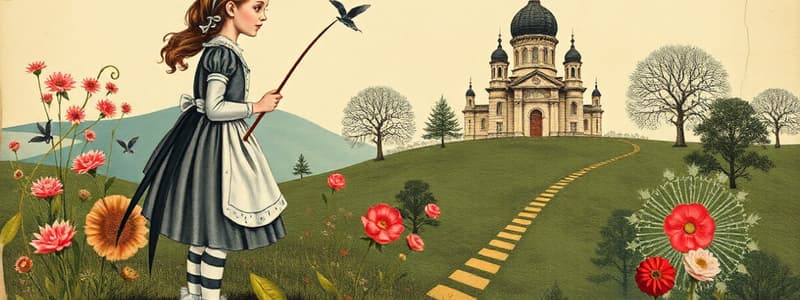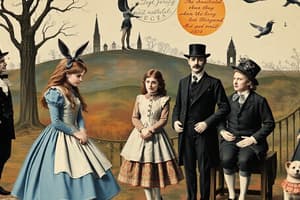Podcast
Questions and Answers
Which character is most emblematic of the rigid or nonsensical nature of power structures in Alice's Adventures in Wonderland?
Which character is most emblematic of the rigid or nonsensical nature of power structures in Alice's Adventures in Wonderland?
- The White Rabbit
- The Caterpillar
- The Queen of Hearts (correct)
- The Mad Hatter
Which theme in Alice's Adventures in Wonderland does the constant shape-shifting and bizarre logic of the environment most directly represent?
Which theme in Alice's Adventures in Wonderland does the constant shape-shifting and bizarre logic of the environment most directly represent?
- Questioning identity and reality (correct)
- The challenges of growing up
- The importance of social decorum
- The rigid structure of Victorian society
Which character serves as the initial catalyst for Alice's entrance into the fantastical world of Wonderland?
Which character serves as the initial catalyst for Alice's entrance into the fantastical world of Wonderland?
- The Cheshire Cat
- The Queen of Hearts
- The Mad Hatter
- The White Rabbit (correct)
A central theme of Alice's Adventures in Wonderland is often seen as a critique of the absurdities in ____.
A central theme of Alice's Adventures in Wonderland is often seen as a critique of the absurdities in ____.
Which character is known for their cryptic advice and ability to vanish?
Which character is known for their cryptic advice and ability to vanish?
Which character could be interpreted as symbolizing the anxieties associated with adulthood?
Which character could be interpreted as symbolizing the anxieties associated with adulthood?
Which of the following best describes the function of the nonsensical elements within Alice's Adventures in Wonderland?
Which of the following best describes the function of the nonsensical elements within Alice's Adventures in Wonderland?
The tea parties in Alice's Adventures in Wonderland are most closely associated with which two characters?
The tea parties in Alice's Adventures in Wonderland are most closely associated with which two characters?
What aspect of the story reflects the theme of power dynamics?
What aspect of the story reflects the theme of power dynamics?
How does the narrative style of Alice's Adventures in Wonderland contribute to its themes?
How does the narrative style of Alice's Adventures in Wonderland contribute to its themes?
Which of the following best describes the significance of the story's whimsical elements?
Which of the following best describes the significance of the story's whimsical elements?
What role does time play in the narrative of Wonderland?
What role does time play in the narrative of Wonderland?
What effect has Alice's Adventures in Wonderland had on popular culture?
What effect has Alice's Adventures in Wonderland had on popular culture?
Flashcards
Power Dynamics
Power Dynamics
The relationship between characters where one holds power and the other doesn't, as seen in the Queen of Hearts and Alice.
First-Person Narrative
First-Person Narrative
The story is told from Alice's point of view, allowing us to see the events through her eyes.
Surreal Situations
Surreal Situations
The world of Wonderland is strange and illogical, with events that don't make sense in the real world.
Nonsensical Dialogue
Nonsensical Dialogue
Signup and view all the flashcards
Time and Perception
Time and Perception
Signup and view all the flashcards
What is Alice's Adventures in Wonderland?
What is Alice's Adventures in Wonderland?
Signup and view all the flashcards
Who is the main character and what happens to her?
Who is the main character and what happens to her?
Signup and view all the flashcards
Who is the White Rabbit?
Who is the White Rabbit?
Signup and view all the flashcards
Who is the Cheshire Cat?
Who is the Cheshire Cat?
Signup and view all the flashcards
Who is the Mad Hatter?
Who is the Mad Hatter?
Signup and view all the flashcards
Who is the March Hare?
Who is the March Hare?
Signup and view all the flashcards
Who is the Queen of Hearts?
Who is the Queen of Hearts?
Signup and view all the flashcards
What is a main theme in Alice's Adventures in Wonderland?
What is a main theme in Alice's Adventures in Wonderland?
Signup and view all the flashcards
Study Notes
Overview of Alice's Adventures in Wonderland
- Lewis Carroll's Alice's Adventures in Wonderland is a children's story published in 1865, known for its nonsensical logic, vivid characters, and fantastical elements.
- The story follows Alice, a young girl, who falls down a rabbit hole into a bizarre, populated world of anthropomorphic animals and unusual creatures.
- The book examines themes of growing up, societal expectations of the Victorian era, and the nature of reality.
- The narrative is a satire of Victorian society, highlighting its absurdities and contradictions.
Characters
- Alice: The protagonist. Her curiosity and resilience are key aspects of the story.
- The White Rabbit: Initiates Alice's journey into Wonderland. He is portrayed as flustered and disorganized, reflecting aspects of adult anxieties.
- The Cheshire Cat: An enigmatic character known for its mischievous nature and cryptic wisdom. Its disappearing and reappearing qualities represent the unpredictable nature of Wonderland.
- The Mad Hatter: A perpetually confused and eccentric character, representing the absurdities of the story. He is associated with tea parties.
- The March Hare: Another eccentric character associated with tea parties.
- The Queen of Hearts: A tyrannical and often irrational ruler, embodying injustices and senselessness in power structures.
- The Dormouse: A sleepy character, representing lethargy in extraordinary circumstances.
- The Caterpillar: A wise and enigmatic creature offering guidance to Alice, emphasizing introspection and questioning one's perspective.
Themes
- Growing up: Alice's experiences are metaphors for the challenges of transitioning from childhood to adulthood.
- Societal Expectations: Characters and events frequently reflect the rigid social expectations and incongruencies within Victorian society.
- Identity and Reality: The story examines the subjective and fluid nature of reality, challenging Alice's perception of herself.
- Logic and Absurdity: The illogical and nonsensical elements are central to the story, prompting readers to question reason's boundaries.
- Power Dynamics: The Queen of Hearts exemplifies a power dynamic opposed to Alice's sense of order and reason.
- Time and Perception: Shifting time frames and distorted perceptions symbolize the fluidity of time and the subjectivity of perception.
Structure and Style
- The story is presented from Alice's first-person perspective.
- The book's style combines vivid imagery, nonsensical dialogue, and surreal situations to create a fantastical world.
- It employs whimsical narrative techniques and symbolic representations for a layered understanding of character and circumstance.
Significance
- Alice's Adventures in Wonderland has significant cultural impact, influencing literature, art, and popular culture.
- Its themes remain relevant to modern readers facing challenges.
- It resonates with both children and adults, with its fantastical and nonsensical elements captivating readers.
- The book has been adapted into numerous films, stage productions, and other forms of media, solidifying its place in popular culture.
Studying That Suits You
Use AI to generate personalized quizzes and flashcards to suit your learning preferences.




